"C" BATTERY
by George B. Turrell, Jr.
Photographs by Morris Gordon
The story of a Nike guided missile battery
its men, its weapon, its vital mission
and its place in a typical American community.
Reprinted from WE magazine, Western Electric Company, Inc.
" C" BATTERY ... Its weapon is W.E.'s Nike; its job is
waiting
The Virginia countryside looks much as it always
has on an early summer day. Only the low green
buildings look new-and the raw ground around them
on which the grass has not yet grown. And beyond
the green buildings stands a cluster of boxlike olive
drab trailers-and further off are the antennas that
turn and turn again-ceaselessly. Their invisible
beams constantly probe the sky far beyond the neigh
boring pasture where the Holsteins chew their cuds
in the somnolence of midday, far beyond the little
white church over against the woods, aid beyond even
the Capitol dome and the great complex of Washing
ton that lies over the hills a few miles away.
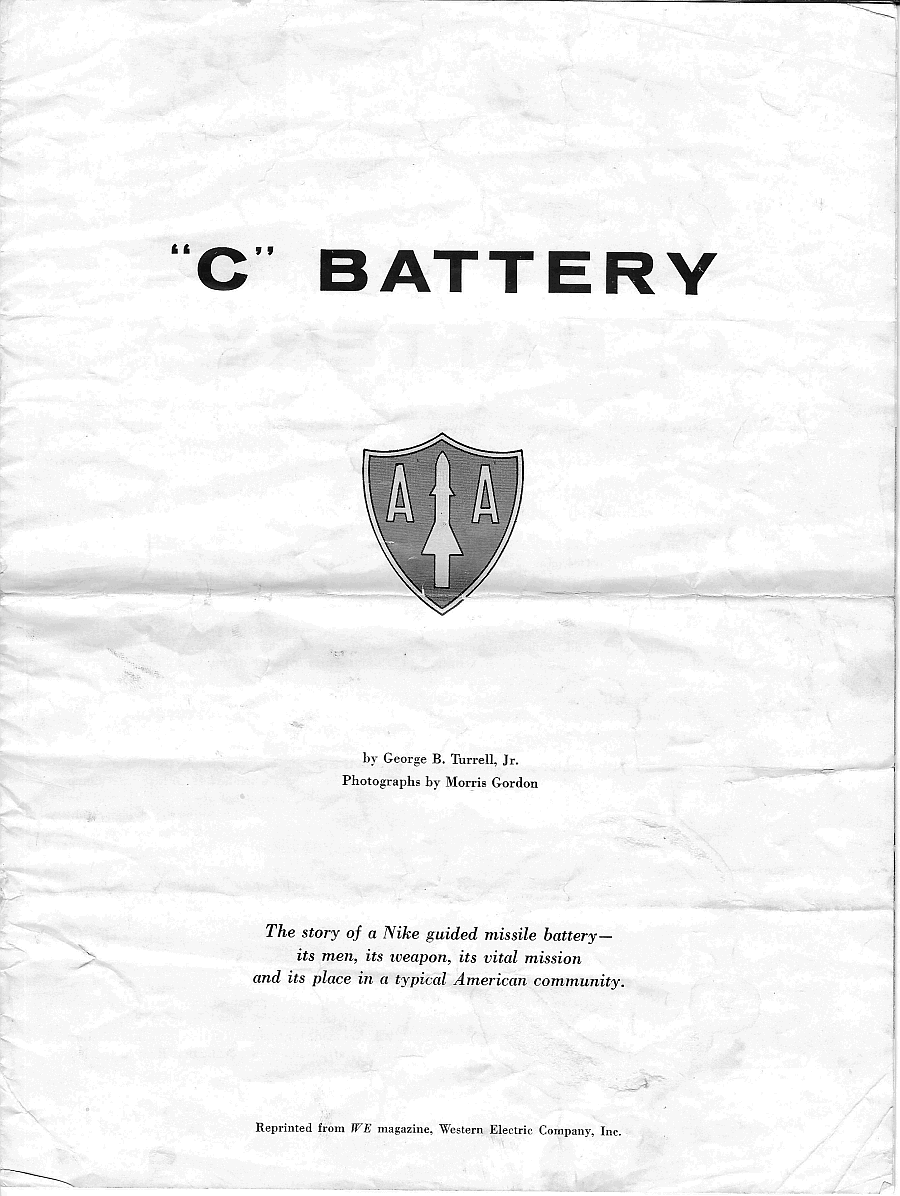
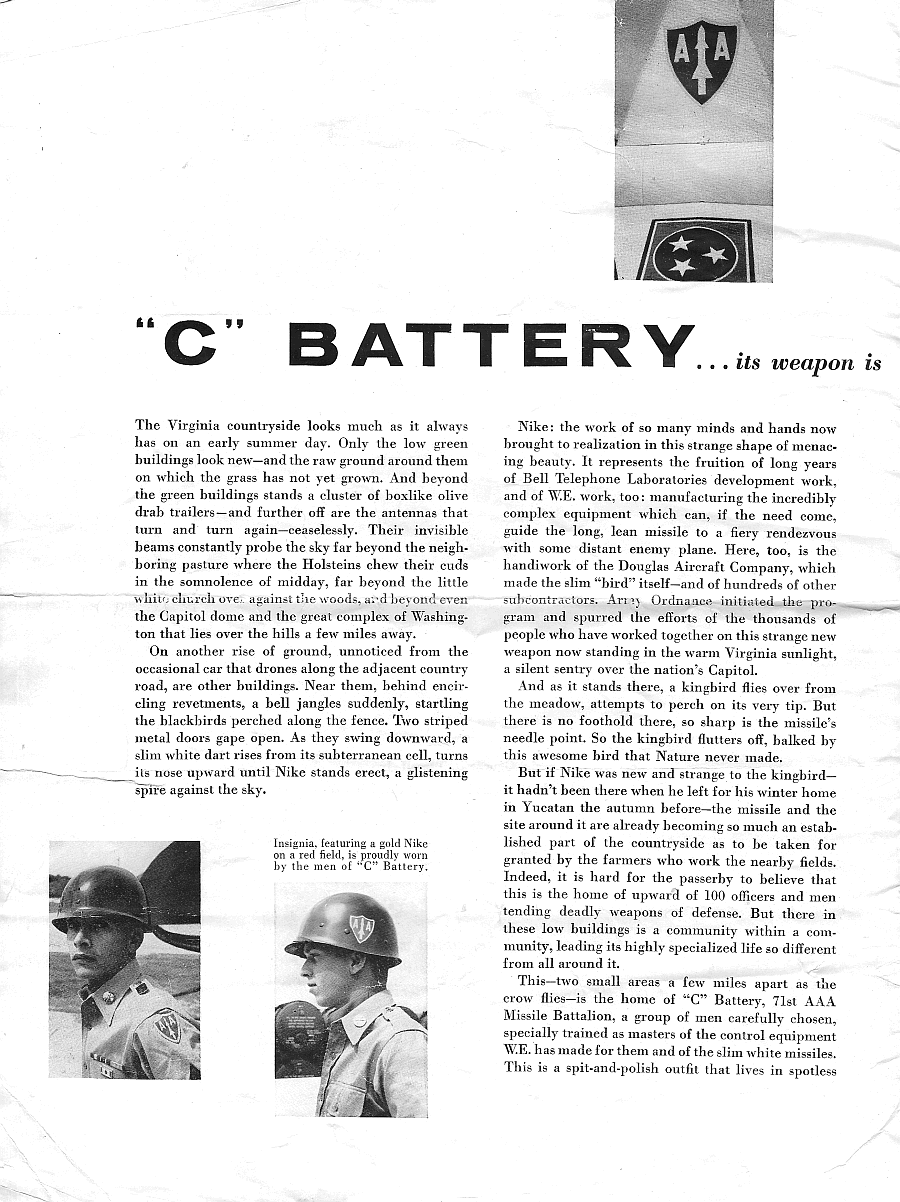
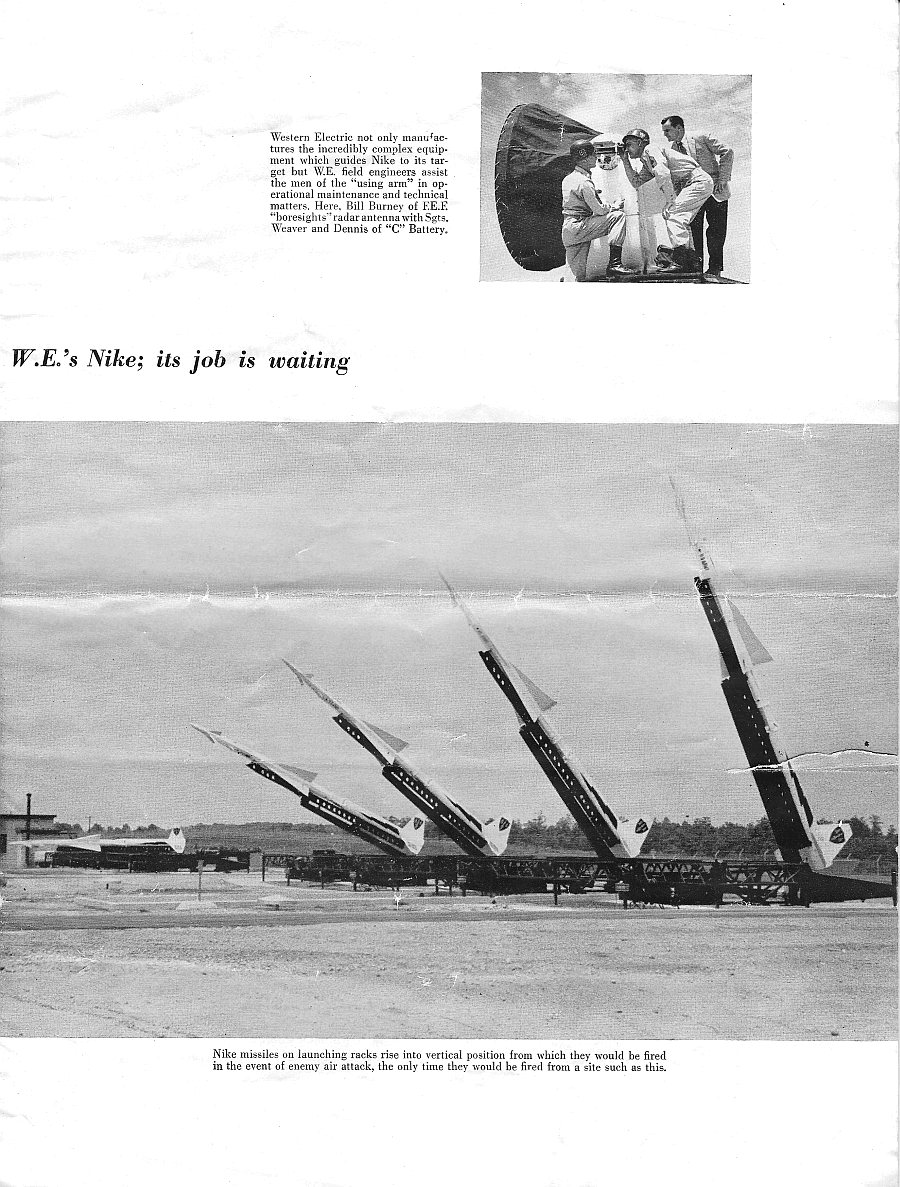
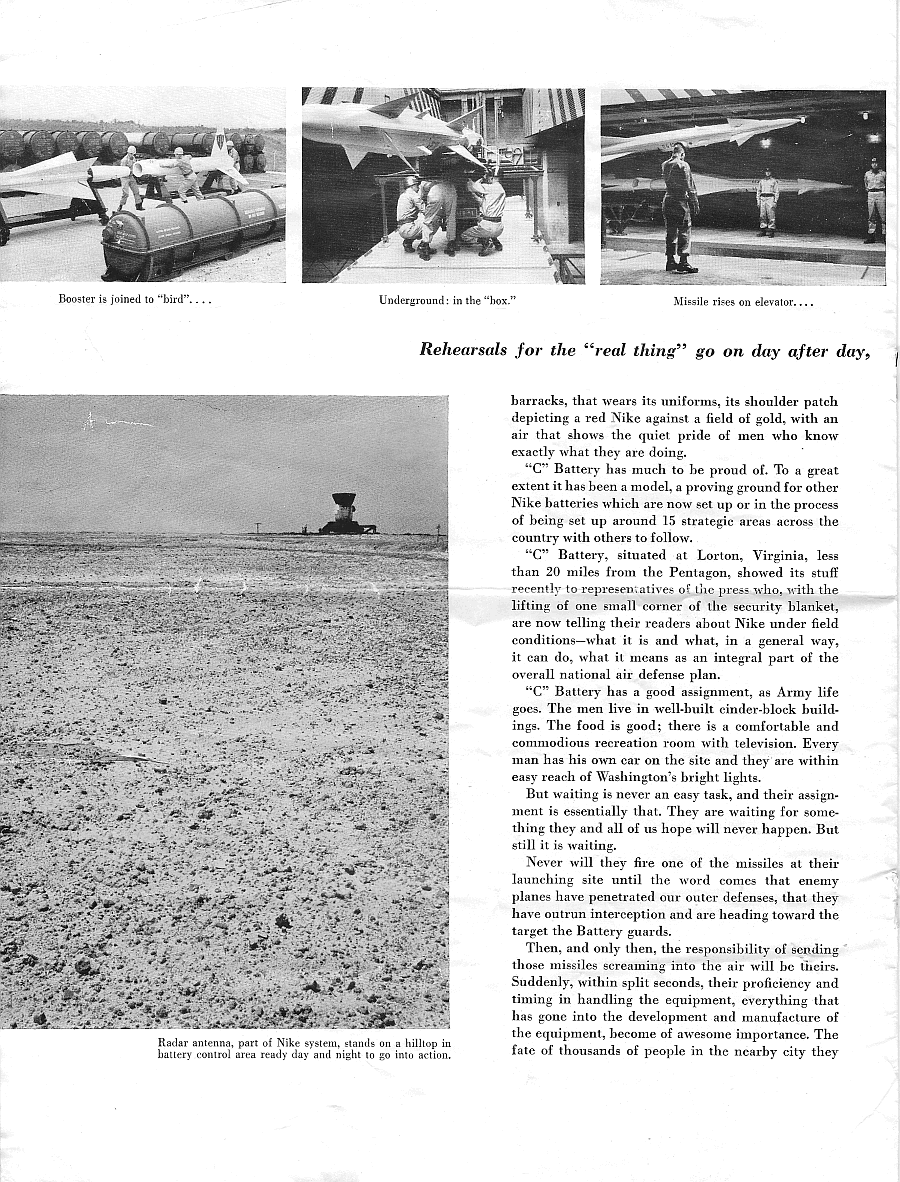
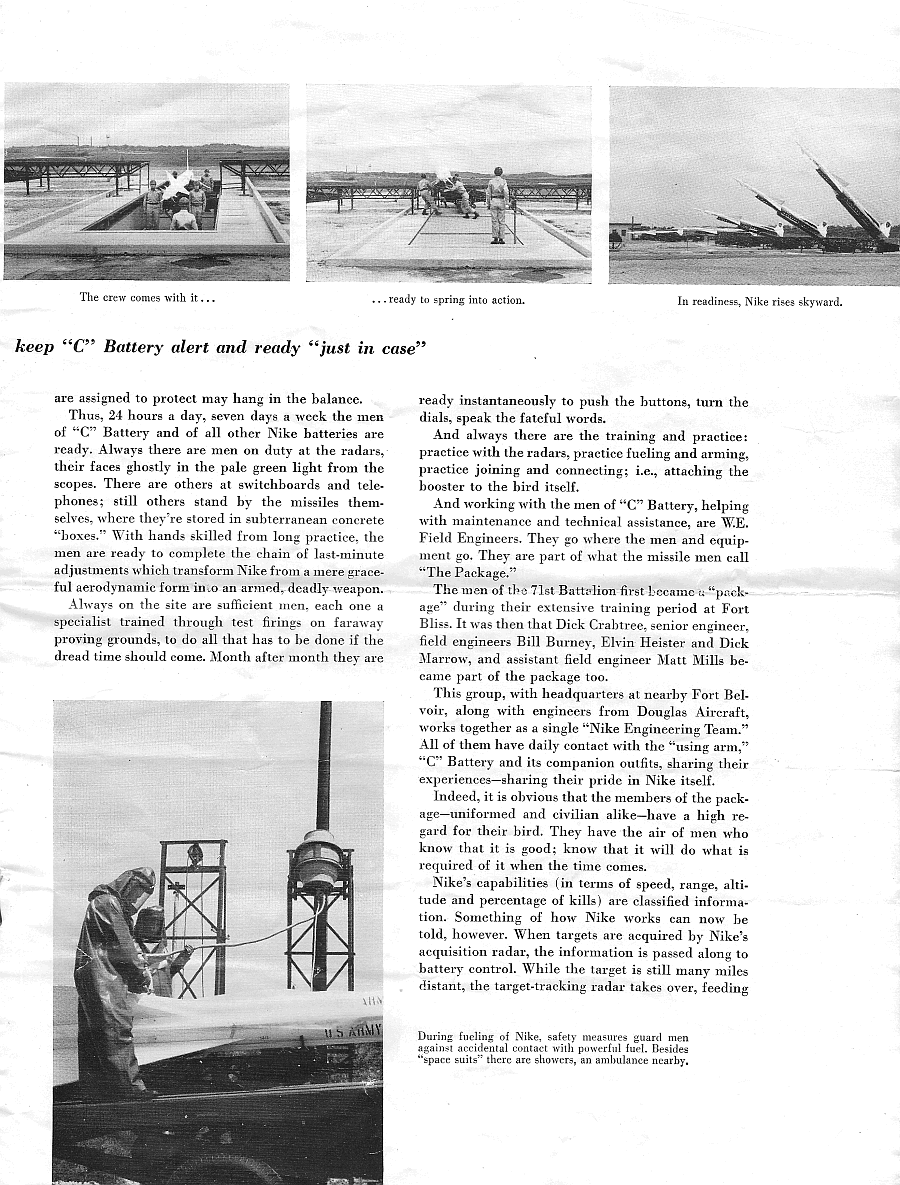
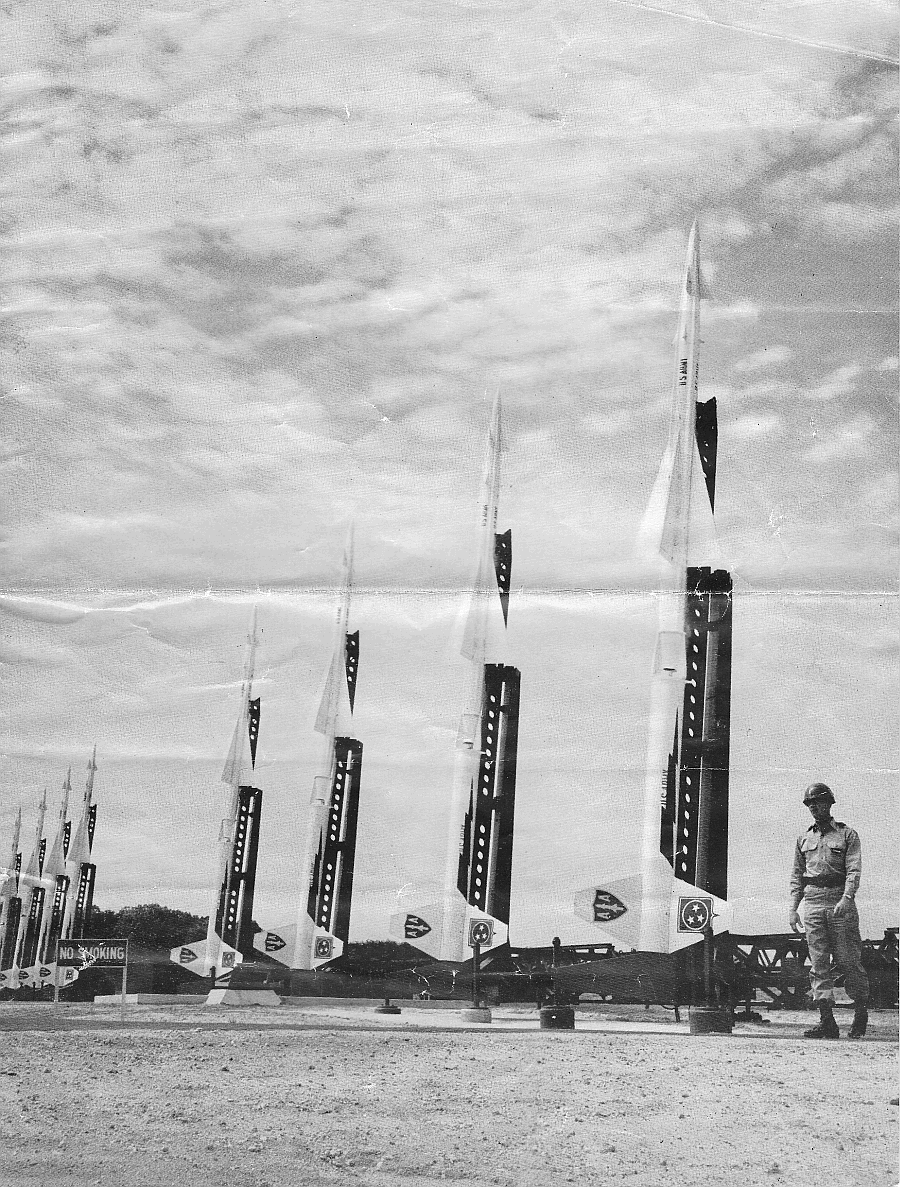
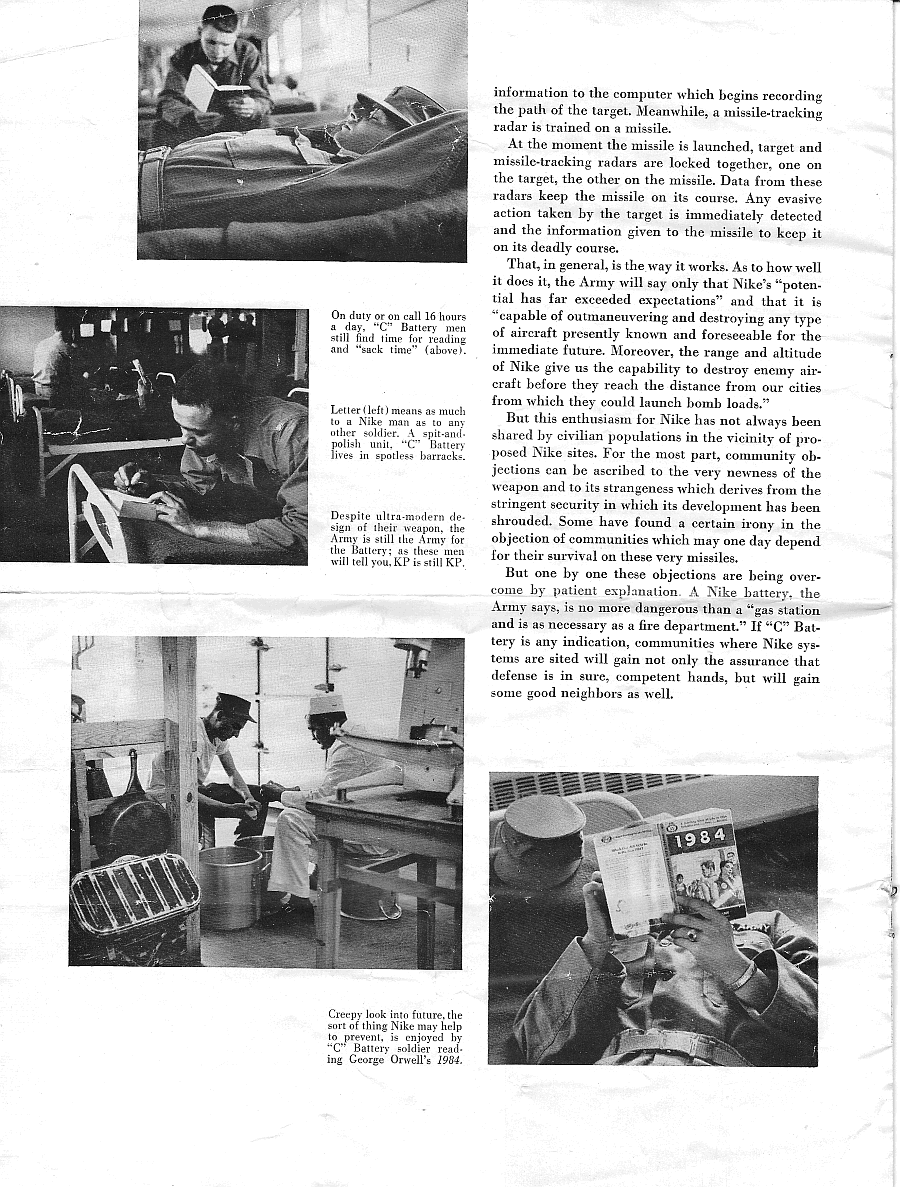
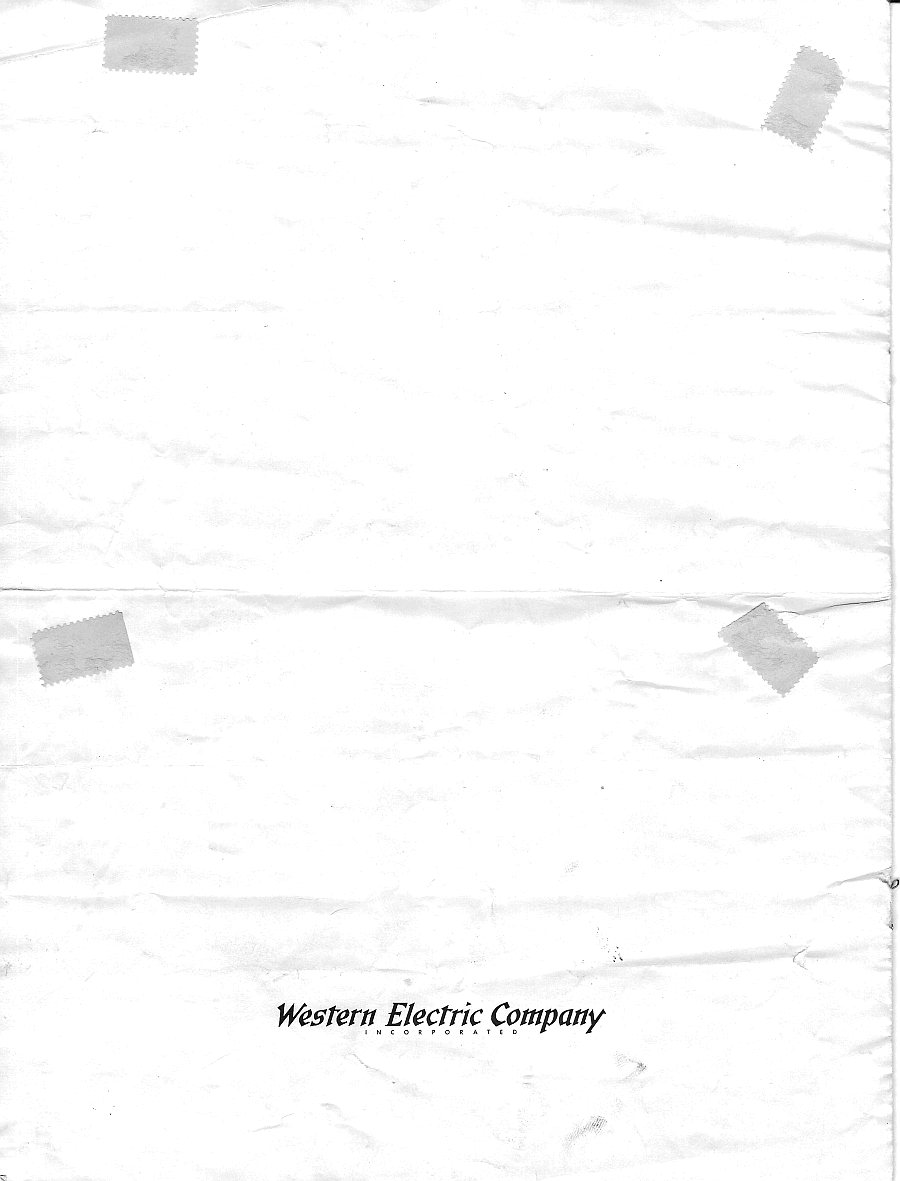
"C" BATTERY
by George B. Turrell, Jr.
Photographs by Morris Gordon
The story of a Nike guided missile battery
its men, its weapon, its vital mission
and its place in a typical American community.
Reprinted from WE magazine, Western Electric Company, Inc.
" C"
BATTERY ...
its weapon is W.E.'s Nike;
its job IS waiting
The Virginia countryside looks much as it always
has on an early summer day. Only the low green
buildings look new-and the raw ground around them
on which the grass has not yet grown. And beyond
the green buildings stands a cluster of boxlike olive
drab trailers-and further off are the antennas that
turn and turn again-ceaselessly. Their invisible
beams constantly probe the sky far beyond the neigh
boring pasture where the Holsteins chew their cuds
in the somnolence of midday, far beyond the little
whit" church ove.. against the woods, aid beyond even
the Capitol dome and the great complex of Washing
ton that lies over the hills a few miles away.
On another rise of ground, unnoticed from the
occasional car that drones along the adjacent country
road, are other buildings. Near them, behind encir
cling revetments, a bell jangles suddenly, startling
the blackbirds perched along the fence. Two striped
metal doors gape open. As they swing downward, a
slim white dart rises from its subterranean cell, turns
- its nose upward until Nike stands erect, a glistening
spire against the sky.
Insignia, featuring a gold Nike
on a red field, is proudly worn
by the men of "C" Battery.
Nike: the work of so many minds and hands now
brought to realization in this strange shape of menac
ing beauty. It represents the fruition of long years
of Bell Telephone Laboratories development work,
and of W.E. work, too: manufacturing the incredibly
complex equipment which can, if the need come,
guide the long, lean missile to a fiery rendezvous
with some distant enemy plane. Here, too, is the
handiwork of the Douglas Aircraft Company, which
made the slim "bird" itself-and of hundreds of other
subcontractors. Ar1:!) Ordna nee initiated the pro
gram and spurred the efforts of the thousands of
people who have worked together on this strange new
weapon now standing in the warm Virginia sunlight,
a silent sentry over the nation's Capitol.
And as it stands there, a kingbird flies over from
the meadow, attempts to perch on its very tip. But
there is no foothold there, so sharp is the missile's
needle point. So the kingbird flutters off, balked by
this awesome bird that Nature never made.
But if Nike was new and strange to the kingbird
it hadn't been there when he left for his winter home
in Yucatan the autumn before-the missile and the
site around it are already becoming so much an estab
lished part of the countryside as to he taken for
granted by the farmers who work the nearby fields.
Indeed, it is hard for the passerby to believe that
this is the home of upward of 100 officers and men
tending deadly weapons of defense. But there in
these low buildings is a community within a com
munity, leading its highly specialized life so different
from all around it.
r
This-two small areas a few miles apart as the
crow flies-is the home of "C" Battery, 71st AAA
Missile Battalion, a group of men carefully chosen,
specially trained as masters of the control equipment
W.E. has made for them and of the slim white missiles.
This is a spit-and-polish outfit that lives in spotless
Western Electric not only manufac
tures the incredibly complex equip
ment which guides Nike to its tar
get but W.E. field engineers assist
the men of the "using arm" in op
erational maintenance and technical
matters. Here, Bill Burney of F.E.F.
"boresights" radar antenna with Sgts,
Weaver and Dennis of "C" Battery.
Nike missiles on launching racks rise into vertical position from which they would be fired
in the event of enemy air attack, the only time they would he fired from a site such as this.
Booster is joined to "bird" ....
Underground: in the "box."
Missile rises on elevator. ...
Rehearsals for the "real thing" go on day after day,
Radar antenna, part of Nike system, stands on a hilltop in
battery control area ready day and night to go into action.
barracks, that wears its uniforms, its shoulder patch
depicting a red Nike against a field of gold, with an
air that shows the quiet pride of men who know
exactly what they are doing.
"C" Battery has much to be proud of. To a great
extent it has been a model, a proving ground for other
Nike batteries which are now set up or in the process
of being set up around 15 strategic areas across the
country with others to follow.
"C" Battery, situated at Lorton, Virginia, less
than 20 miles from the Pentagon, showed its stuff
recently to representatives of the press who, with the
lifting of one small corner of the security blanket,
are now telling their readers about Nike under field
conditions-what it is and what, in a general way,
it can do, what it means as an integral part of the
overall national air defense plan.
"C" Battery has a good assignment, as Army life
goes. The men live in well-built cinder-block build
ings. The food is good; there is a comfortable and
commodious recreation room with television. Every
man has his own car on the site and they are within
easy reach of Washington's bright lights.
But waiting is never an easy task, and their assign
ment is essentially that. They are waiting for some
thing they and all of us hope will never happen. But
still it is waiting.
Never will they fire one of the missiles at their
launching site until the word comes that enemy
planes have penetrated our outer defenses, that they
have outrun interception and are heading toward the
target the Battery guards.
Then, and only then, the responsibility of sending ~
those missiles screaming into the air will be theirs.
Suddenly, within split seconds, their proficiency and
timing in handling the equipment, everything that
has gone into the development and manufacture of
the equipment, become of awesome importance. The
fate of thousands of people in the nearby city they
The crew comes with it ..•
keep "C" Battery alert and ready "just In case"
are assigned to protect may hang in the balance.
Thus, 24 hours a day, seven days a week the men
of "C" Battery and of all other Nike batteries are
ready. Always there are men on duty at the radars.:
their faces ghostly in the pale green light from the
scopes. There are others at switchboards and tele
phones; still others stand by the missiles them
selves, where they're stored in subterranean concrete
"boxes." With hands skilled from long practice, the
men are ready to complete the chain of last-minute
adjustments which transform Nike from a mere grace
ful aerodynamic form into an armed, deadly weapon.
Always on the site are sufficient men, each one a
specialist trained through test firings on faraway
proving grounds, to do all that has to be done if the
dread time should come. Month after month they are
•
f '
. . . ready to spring into action.
In readiness, Nike rises skyward .
ready instantaneously to push the buttons, turn the
dials, speak the fateful words.
And always there are the training and practice:
practice with the radars, practice fueling and arming,
practice joining and connecting; i.e., attaching the
booster to the bird itself.
And working with the men of "C" Battery, helping
with maintenance and technical assistance, are W.E.
Field Engineers. They go where the men and equip
ment go. They are part of what the missile men call
"The Package."
The men of the 71st Battalimrfirst1:·ecamc ::-"p:<cl,,
age" during their extensive training period at Fort
Bliss. It was then that Dick Crabtree, senior engineer,
field engineers Bill Burney, Elvin Heister and Dick
Marrow, and assistant field engineer Matt Mills be
came part of the package too.
This group, with headquarters at nearby Fort Bel
voir, along with engineers from Douglas Aircraft,
works together as a single "Nike Engineering Team."
All of them have daily contact with the "using arm,"
"C" Battery and its companion outfits, sharing their
experiences-sharing their pride in Nike itself.
Indeed, it is obvious that the members of the pack
age-uniformed and civilian alike-have a high re
gard for their bird. They have the air of men who
know that it is good; know that it will do what is
required of it when the time comes .
Nike's capahilities (in terms of speed, range, alti
tude and percentage of kills) are classified informa
tion. Something of how Nike works can now he
told, however. When targets are acquired by Nike's
acquisition radar, the information is passed along to
battery control. While the target is still many miles
distant, the target-tracking radar takes over, feeding
During fueling of Nike, safety measures guard men
against accidental contact with powerful fuel. Besides
"space suits" there are showers, an ambulance nearby.
On duty or on call 16 hours
a day, "C" Battery men
still find time for reading
and "sack time" (above).
Letter (left) means as much
to a Nike man as to any
other soldier. A spit-and
polish unit, "C" Battery
lives in spotless barracks.
Despite ultra-modern de
sign of their weapon, the
Army is still the Army for
the Battery; as these men
will tell you, KP is still KP.
Creepy look into future, the
sort of thing Nike may help
to prevent, is enjoyed by
"C" Battery soldier read
ing George Orwell's 1984.
information to the computer which begins recording
the path of the target. Meanwhile, a missile-tracking
radar is trained on a missile.
At the moment the missile is launched, target and
missile-tracking radars are locked together, one on
the target, the other on the missile. Data from these
radars keep the missile on its course. Any evasive
action taken by the target is immediately detected
and the information given to the missile to keep it
on its deadly course.
That, in general, is the way it works. As to how well
it does it, the Army will say only that Nike's "poten
tial has far exceeded expectations" and that it is
"capable of outmaneuvering and destroying any type
of aircraft presently known and foreseeable for the
immediate future. Moreover, the range and altitude
of Nike give us the capability to destroy enemy air
craft before they reach the distance from our cities
from which they could launch bomb loads."
But this enthusiasm for Nike has not always been
shared by civilian populations in the vicinity of pro
posed Nike sites. For the most part, community ob
jections can be ascribed to the very newness of the
weapon and to its strangeness which derives from the
stringent security in which its development has been
shrouded. Some have found a certain irony in the
objection of communities which may one day depend
for their survival on these very missiles.
But one by one these objections are being over
come by patient explanation. A Nike battery, the
Army says, is no more dangerous than a "gas station
and is as necessary as a fire department." If "C" Bat
tery is any indication, communities where Nike sys
tems are sited will gain not only the assurance that
defense is in sure, competent hands, but will gain
some good neighbors as well. . |